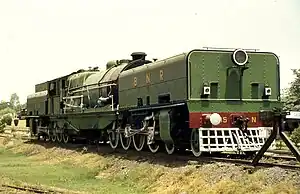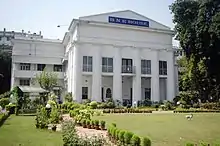Bengal Nagpur Railway
The Bengal Nagpur Railway was one of the companies which pioneered development of the railways in eastern and central India. It was succeeded first by Eastern Railway and subsequently by South Eastern Railway.
 | |
| Industry | Railways |
|---|---|
| Founded | 1887 |
| Defunct | 1952 (Merged with East Indian Railway Company to form Eastern Railway) |
| Headquarters | , |
Area served | Eastern and Central India |
| Services | Rail transport |
| Subsidiaries | Bengal Nagpur Railway |




History
The opening of the Mumbai–Thane line in 1853 marked the beginning of railways in India. Extension of the railways was set off throughout the country. On the north-eastern side of Mumbai, the Great Indian Peninsular Railway line was extended up to Bhusawal and then split in two. While one track led to Nagpur, the other to Jabalpur to connect with the East Indian Railway line from Allahabad to Jabalpur, thereby connecting Mumbai and Kolkata. The great famine of 1878 provided an opportunity for the construction of 150 km long meter gauge link called the Nagpur Chhattisgarh Railway in 1882 connecting Nagpur with Rajnandgaon.[1]
The Bengal Nagpur Railway was formed in 1887 for the purpose of upgrading the Nagpur Chhattisgarh Line and then extending it via Bilaspur to Asansol, in order to develop a shorter Howrah-Mumbai route than the one via Allahabad.[1] The Nagpur Chhattisgarh Railway was owned by the provincial government.[2] Bengal Nagpur Railway was formed in 1887.[3] The Nagpur Chhattisgarh Railway was purchased from Great Indian Peninsula Railway by Bengal Nagpur Railway in 1888, and was converted to broad gauge.[2] The Bengal Nagpur Railway main line from Nagpur to Asansol was opened for goods traffic on 1 February 1891.[4] It was only after Kharagpur was linked from the west and the south that it was connected to Howrah in 1900.[5]
Although Bengal Nagpur Railway was not a part of original design to connect major points in the subcontinent with a network of railways, it was instrumental in developing a shorter, and hence more popular, route from Howrah to Mumbai and the trunk route from Howrah to Chennai.[1][4][5]
The civil engineer Lt Col Arthur John Barry was the Executive Engineer in charge of the construction of the bridge over the Damodar River and the work of the Damodar district of the Bengal-Nagpur Railway, of which he was afterwards Superintending Engineer of the Bengal section.[6]
Indian officers played a major role in the management of the BNR from the second quarter of the twentieth century. Major (Hon.) Basanta Kumar De, who retired as Commercial Traffic Manager played a pivotal role in surveying for the laying of tracks between Raipur and Vizianagram and Sonepur and Bolangir in the 1930s.
In 1925, Bengal Nagpur Railway purchased five steam railcars from Sentinel and Metro-Cammell.[7][8] In 1936 the company owned 802 locomotives, 5 railcars, 692 coaches and 25.434 goods wagons.[9]
The management of the Bengal Nagpur Railway was taken over by the Government of India in 1944.[4] Eastern Railway was formed on 14 April 1952 with the portion of East Indian Railway Company east of Mughalsarai and the Bengal Nagpur Railway.[10] In 1955, South Eastern Railway was carved out of Eastern Railway. It comprised lines mostly operated by BNR earlier.[10][11] Amongst the new zones started in April 2003 were East Coast Railway and South East Central Railway and South Coast Railway was bifurcated between ECOR and SCR and a new Zone was formed in Visakahapatnam as Headquarters. Both these railways were carved out of South Eastern Railway.[10]
Classification
It was labeled as a Class I railway according to Indian Railway Classification System of 1926.[12][13]
References
- "Number 1 Down Mail". Railways of the Raj. Retrieved 19 February 2012.
- "Nagpur Chhattisgarh Railway". fibis. Retrieved 19 February 2012.
- "Bengal-Nagpur Railway". fibis. Retrieved 19 February 2012.
- "Major Events in the Formation of S.E. Railway". South Eastern Railway. Archived from the original on 1 April 2013. Retrieved 19 February 2012.
- R.P.Saxena. "Indian Railway History timeline". Archived from the original on 14 July 2012. Retrieved 19 February 2012.
- Frederick Arthur Crisp Visitation of England and Wales, Volume 14, London (1906)
- Ostendorf, Rolf (1977). Dampftriebwagen, Bauarten, Typen und Systeme (in German). Motorbuchverlag, Stuttgart. p. 159-160. ISBN 3-87943-517-0.
- "Bengal Nagpur, Articulated Sentinel-Cammell steam railcar, mid 1920's". Flickr. 27 June 2017. Retrieved 24 May 2022.
- World Survey of Foreign Railways. Transportation Division, Bureau of foreign and domestic commerce, Washington D.C. 1936. p. 211.
- "Geography – Railway Zones". IRFCA. Retrieved 21 November 2012.
- "IR History: Part - IV (1947 - 1970)". IRFCA. Retrieved 21 November 2012.
- "Indian Railway Classification". Retrieved 10 November 2022.
- World Survey of Foreign Railways. Transportation Division, Bureau of foreign and domestic commerce, Washington D.C. 1936. pp. 210–219.